WhisperRoom™ is a proud sponsor of the podcast Recording Studio Rockstars. In each episode, Lij Shaw interviews music producers, engineers, studio owners, and other professionals to bring you inspiring stories, tricks, and insight from the recording industry.
You can listen to the entire podcast archive of Recording Studio Rockstars here or from your favorite podcast app.
RSR Episode #235: Casey Barker | How to Find Your Dream Job in Recording & Mixing
In this episode of Recording Studio Rockstars, Casey Barker talks about his time interning at Paragon Studios, becoming the mixer for 7 series of the Veggie Tales TV show, connecting with your audience as an artist, engineer, or producer, and how to identify and find your dream job in the recording industry.
Listen to the full episode here or stream it in the video below!
About Casey Barker
Ohio Native, Casey Barker, has been living and working in the Nashville area for the last 12 years. Casey is a Record Producer/Mixer and a Supervising Sound Editor/Re-recording Mixer for Television and Film.
Additionally, Casey is the owner and found of ModernMusicBusiness.com – a website dedicated to showing people how to successfully obtain their dream career in the entertainment business.
6 Ways to Energize Your E-learning NarrationsA tremendous amount of learning takes place outside of the traditional classroom. Every day, millions of internet users tune into online courses to complete training, learn new skills, take virtual tests, or learn from an instructor. E-learning is a fascinating new way to learn.
Although the modern learning environment has changed, one thing might always stay the same – it’s tough to learn from a boring teacher. With that being said, we hope the following suggestions will help you energize your E-learning narrations.
Create Engaging Narrations
Narrations should aim to captivate and engage the audience. Research suggests that students who are engaged in the learning process have better attention and focus. This kind of attention helps motivate higher-level thinking and creates a meaningful learning experience. Although many professional voice-over artists are natural orators, everyone can still benefit from guidance, feedback, and lots of practice.
1 – Practice Before Recording
It’s always helpful to think before you speak and practice before you hit the record button. Put some thought into the vocal tone and reflections that you plan to use, and think about several different ways that will help you communicate the main points as clearly as possible.
2 – Get Expressive
How you physically express yourself while speaking is just as important as the words you say.
Unless you’re being filmed while talking, the audience cannot see the gestures that you make. The tone of your voice will automatically adapt to your facial expressions and hand gestures.
Still, try your best to add physical emphasis to the words. If you smile, laugh, gesture, or frown, the learner will likely notice your change of tone and will better follow the words that you say. This will better help you get the main point across to the listener.
3 – Stay Relaxed
Be cool, calm, and relaxed while recording. Whatever you do, don’t stress your learners out with a fast-pace and monotone dialogue. Speaking too fast is a no-go, but you should also not bore your listeners by speaking too slow. Just keep it natural, and talk at a normal rate. There’s no need to rush your narrations.
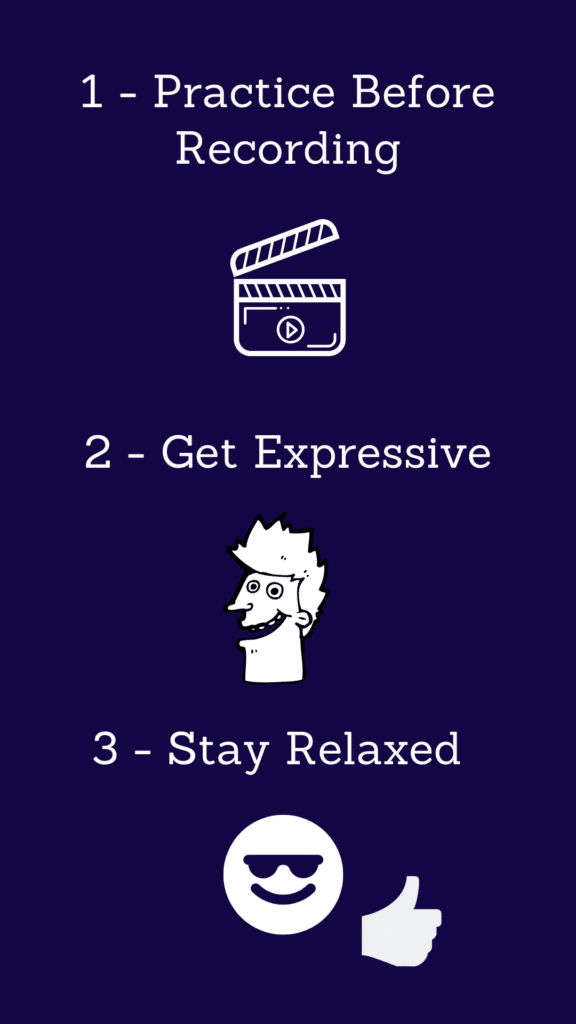
Tips To Improve Poor Audio Quality
Poor audio quality is annoying and distracting. Ambient noise such as the sound of rustling paper, the A/C unit, outdoor traffic sounds, and heaving breathing are just a few examples of what contributes to bad quality audio.
If you’ve been enjoying the benefits of a WhisperRoom sound isolation enclosure (or an alternative isolation booth) ambient noise shouldn’t be an issue. Your objective should be to keep outside noise from entering your recording session. If you don’t have a sound isolation booth, there are still some things you can do to set yourself up for a successful narration:
- Consider recording in a well-carpeted or acoustically treated area – sound loves to bounce off of hard surfaces such as tile, glass, and wood.
- Properly seal air gaps around doors and outlets. This will help keep your room quiet.
- Invest in quality hardware (microphone, interface, etc.)
- Clean up your final recordings by editing out unwanted audio.
4 – Narrate at a Consistent Volume
Consistency is key with E-learning narrations and audio leveling software is a narrator’s best friend. Spend the extra time to adjust the volume of each audio track to make sure they’re at the same level. You can try your best to speak at the same volume for the entire narration, but it’s a good idea to double-check the volume levels of everything that you make before completing the project.
5 – Plan a Long Session
If you’re recording excerpts from an audiobook, textbook, or lecture, it’s helpful to knock out the script in long chunks. Settle yourself and record lengthy portions of text in one sitting to keep a consistent tone and volume. Planning for long sessions will help you create uniform recordings while efficiently managing time.
6 – Remember Your Settings
When you’re working on an ongoing project, it’s helpful to take note of your settings. Look at the gain knob on your interface and remember the level you have it set to. This will help you keep the volume levels of your narration consistent. It’s also important to put some thought into your body position. Take a moment to recognize the placement of your microphone and your proximity to it while speaking.
Lengthy E-learning narrations will take you a few days to complete. So it’s important to be able to pick things right back up from where you left off in the previous session. Creating a logical workflow that’s unique to your style, studio, and preference will allow you to get more work complete with less hassle.
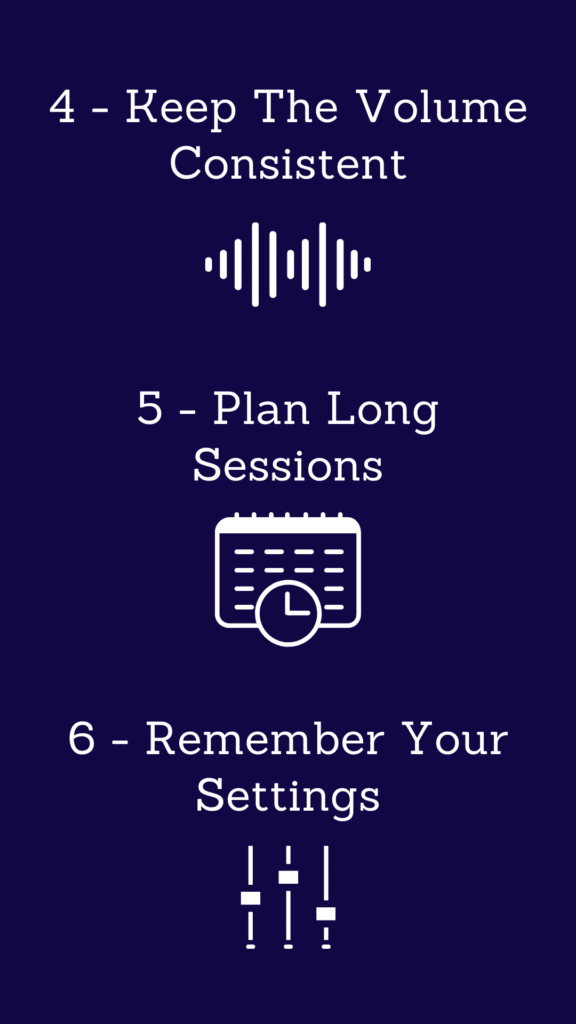
WhisperRoom™ is a proud sponsor of the podcast Recording Studio Rockstars. In each episode, Lij Shaw interviews music producers, engineers, studio owners, and other professionals to bring you inspiring stories, tricks, and insight from the recording industry.
You can listen to the entire podcast archive of Recording Studio Rockstars here or from your favorite podcast app.
RSR Episode #234: Jason Soudah talks about composing film with Matt Margeson at Hans Zimmer’s Remote Control and much more!
In this episode of Recording Studio Rockstars, Jason Soudah talks about interning with Hans Zimmer, arranging with Matt Margeson, composing a song one section at a time, using Sonarworks Ref4 to create massive low end in a film score, and gives some great tips for synths and strings.
Listen to the full episode here or stream it in the video below!
Who is Jason Soudah?
Jason Soudah is a Composer/Singer-Songwriter/Producer/Mix Engineer from the UK. In 2009, Jason was invited to intern at Hans Zimmer’s studio complex and has been based in Los Angeles ever since. Jason was quickly recruited by composer Matthew Margeson (Rocketman, Kingsman: The Secret Service & The Golden Circle, Rings). From then on, the two have become partners in collaboration.
In this “additional music” capacity, Jason has also worked with composers Henry Jackman, Dominic Lewis, Heitor Pereira, Jim Dooley, Al Clay, Daniel Heath, Benjamin Wallfisch, and Ryan Taubert.
As a composer, Jason recently won the Best Music Award at the 2019 Boston Film Festival for his score to the movie “Whaling”. Additional career highlights include scoring the multi-award-winning Horror Feature “Followed“, and the Emmy-Awarded documentary feature “Paradise Reef: The World is Watching.”
Jason has had songs featured on MTV (The Real World, Teen Mom). Jason also wrote “A Sporting Chance” for the movie “Eddie The Eagle, “Ladyphones” for the movie “GI-JOE: Retaliation”, and co-wrote “Handy Candy” for the movie “Miss Peregrine’s Home for Peculiar Children” with composers Matthew Margeson and Mike Higham.
Right now, Jason is writing music for multiple film projects, mixing scores (most recently for BAFTA-supported composer Emily Rice), and collaborating with other songwriters and artists (as a co-writer and/or producer) with a view to creating songs for sync licenses, for the artist/s themselves, or to be cut by other artists. Jason also produces backing tracks for KIDZ BOP, collaborating with Gary Philips.
Soundproof a Room for Guitar and DrumsWhen you’re on stage, there’s nothing better than enjoying the rough punch that a good drumset provides. However, while you’re practicing with your band, this can prove to be a bit too much for your neighbors; regardless of where you are. That’s why knowing how to soundproof a room for drums and guitars is important if you ever want to get your band off the ground.
Bear in mind that professional soundproofing is no small investment; if you want to achieve that, you will need to have quite a bit of money. And even with sufficient funds, we’re talking about a very substantial effort. So, you’ll basically need to do a complete remodel of the room in question or invest in a sound booth.
However, if you’re not prepared for such a huge undertaking – there are still a couple of things that you can do without breaking the bank and spending a whole lot of time. And this will allow you to significantly reduce the amount of sound that others hear outside of your soundproofed room. The primary purpose of the methods we’ll describe below is sound absorption, as you’ll see soon enough.
Finding Air Leaks
While completely sealing off a room from external airflow would shut out most of the sound, the room itself would be too stuffy, hot, and practically unusable for any people inside.
But, you can still work to seal off the bigger leaks of air you can find through soundproof insulation; thus reducing the noise you emit to the outside world. Remember – if air can easily flow between the room and the outside world, the noise from drumming and guitars will flow with the same ease.
Reinforcing The Door
As you might have expected, the most obvious place where you’ll find most of the air leaks from your room is the door. Luckily, there are plenty of amateur kits that you can buy, and which are a great help with the bottom seam of the door, as well as the sides; all of which need to be properly sealed for a soundproof room.
Plus, unless you have a home that was built a while ago with doors made out of solid wood; you probably have a hollow door that’s not too much of a sound barrier.
In fact, the laws of physics say that a hollow door is actually a sound amplifier – in other words, the complete opposite of the effect you want to achieve. With that in mind, you need to reinforce your door with some sort of fiberglass panel. This will help minimize the level of sound that goes outside through the structure of the door itself.
Drum Rug
You may not know this, but if you put a rug beneath your drumset – it will actually manage to soak up a lot of your sound. This is a well-known fact to experienced musicians; that’s why you can buy drum rugs that are specifically designed to reduce the amount of noise the instrument produces.
The design of such rugs is there to make sure that your stands and spurs dig into the rug. That way, you won’t have to think about your overzealous drumming causing some kind of tipping or unwanted movement.
For those who like their drum setup to match their personal aesthetic, there are all kinds of rugs out there; from matte black to oriental rugs. Though, we do recommend that you still only use such drum rugs on floors that have already been carpeted. Otherwise, you should either put rugs across the entire floor or install some carpeting.
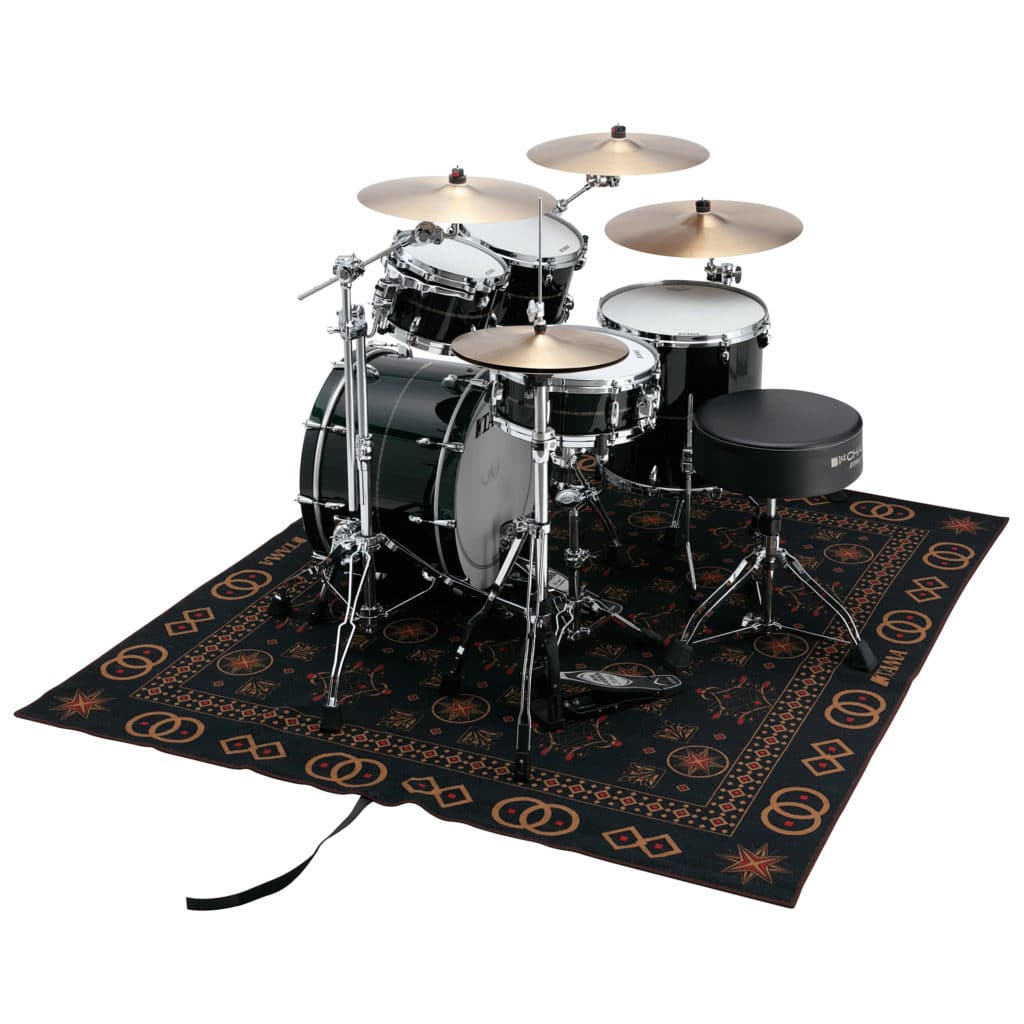
Acoustic Foam
One of the reasons why a drum rug is a good idea is the fact that drums and other instruments produce more noise when you have hard surfaces nearby. The sound you produce can bounce off those, making your band’s music even louder. The same principle is true for the ceiling and walls of your room. Combined with music, they make an effect in which the sound jumps around all the different surfaces, becoming even more amplified. This is why we arrive at perhaps the most important part of this soundproofing guide – acoustic foam.
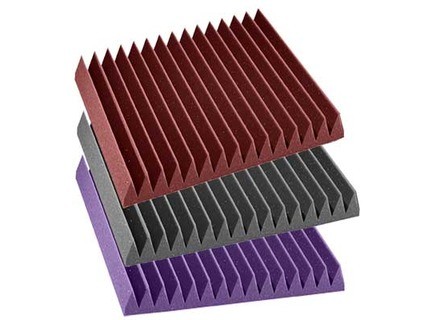
To be more specific, you should cover the entirety of the room (ceiling and walls) with acoustic foam. For those with an overall artsy inclination – you can always arrange these foam pieces in interesting and unique patterns.
Still, the most important effect of this foam is to reduce the echo and reverb that amplify your sound. Bear in mind that a decently-sized room will require more than one pack of foam. If you’re tight with money and can’t afford all the foam needed to cover the entirety of the room’s surface area – don’t despair! As long as you cover at least one-quarter of the room’s size, you’ll do enough to make a noticeable difference. Naturally, the bigger the surface area you cover, the more effective your soundproofing efforts will be.
Drapes on Windows
Even if your band room is inside a house and not an apartment building; there’s still the chance that too much noise is exhibited to the outside world. In that case – you should take care to do something regarding your windows as well.
Once you repeat the leak-finding process you had with the door, you should do the same with your windows. When this is done, all that’s needed to do is to cover them with thick curtains or drapes.
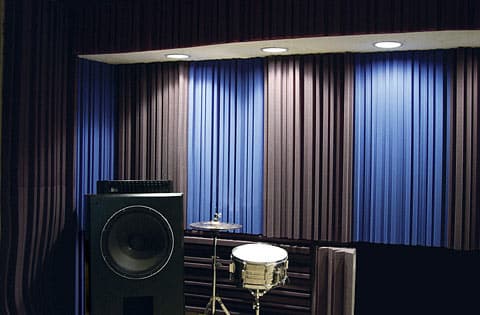
You’d be surprised at just how effective blackout curtains can be when it comes to blocking noise. Plus, if you’re willing to put some more effort and money into your soundproofing, you’ll be able to find specially-made noise-reducing drapes that help with thermal insulation too.
Conclusion
As you have probably realized from the very beginning, all of this is rarely enough compared to professional-grade soundproofing efforts and the noise reduction capabilities of a WhisperRoom™. However, if you don’t want to completely remodel your interior, the steps we’ve showcased above will prove to be surprisingly adept at significantly lowering noise levels and help you soundproof a room.
RSR: Evan Bakke Talks About Recording Prince at Paisley ParkWhisperRoom™ is a proud sponsor of the podcast Recording Studio Rockstars. In each episode, Lij Shaw interviews music producers, engineers, studio owners, and other professionals to bring you inspiring stories, tricks, and insight from the recording industry.
You can listen to the entire podcast archive of Recording Studio Rockstars here or from your favorite podcast app.
RSR Episode #233: Evan Bakke chats about recording Prince at Paisley Park and engineering at Power Station NE
In this episode of Recording Studio Rockstars, Evan Bakke breaks down his vocal chain for Prince at Paisley Park, how to take session notes like a pro, organize your Pro Tools sessions, and shares some mixing tips for your next session.
Listen to the full episode here or stream it in the video below!
Who is Evan Bakke?
Evan Bakke is the Chief Engineer at Power Station New England in Waterford, Connecticut. Originally from Minneapolis, Evan started working under producers Matt Kirkwold and James “Fluff” Harley at MasterMix studios and the Boiler Room. Evan also spent time partnering on many projects with Producer/Mixer Jeremy Tappero at PoundSound in St. Paul.
In 2009, Evan spent a couple of years in La Paz, Bolivia and built a recording studio in Che Geuvara’s old house. Shortly after that, he moved back to Minneapolis to work as Prince’s personal recording engineer in 2013-2014. Most recently in 2015, Evan and his wife moved to Connecticut to become the chief engineer at Power Station, NE.






